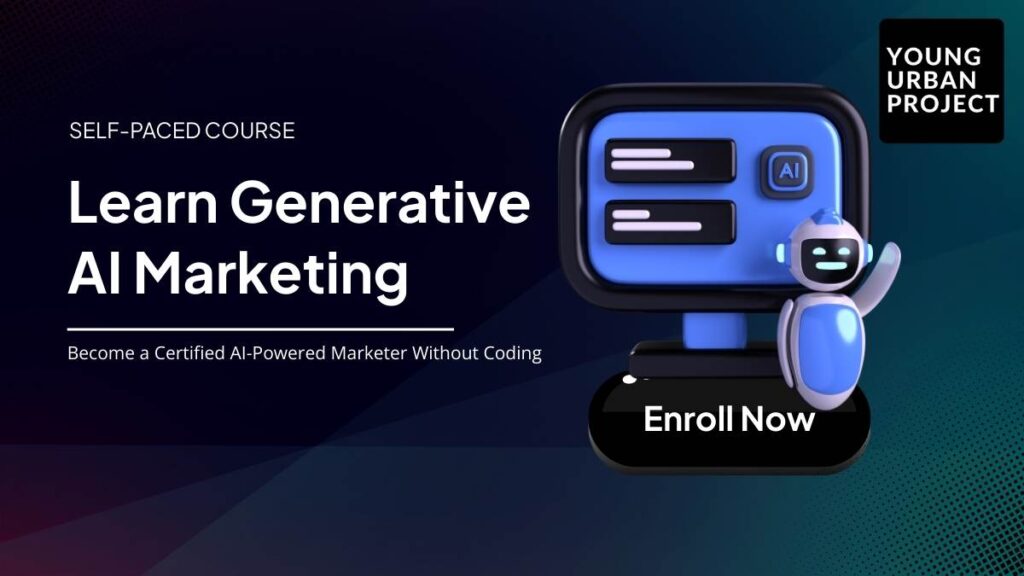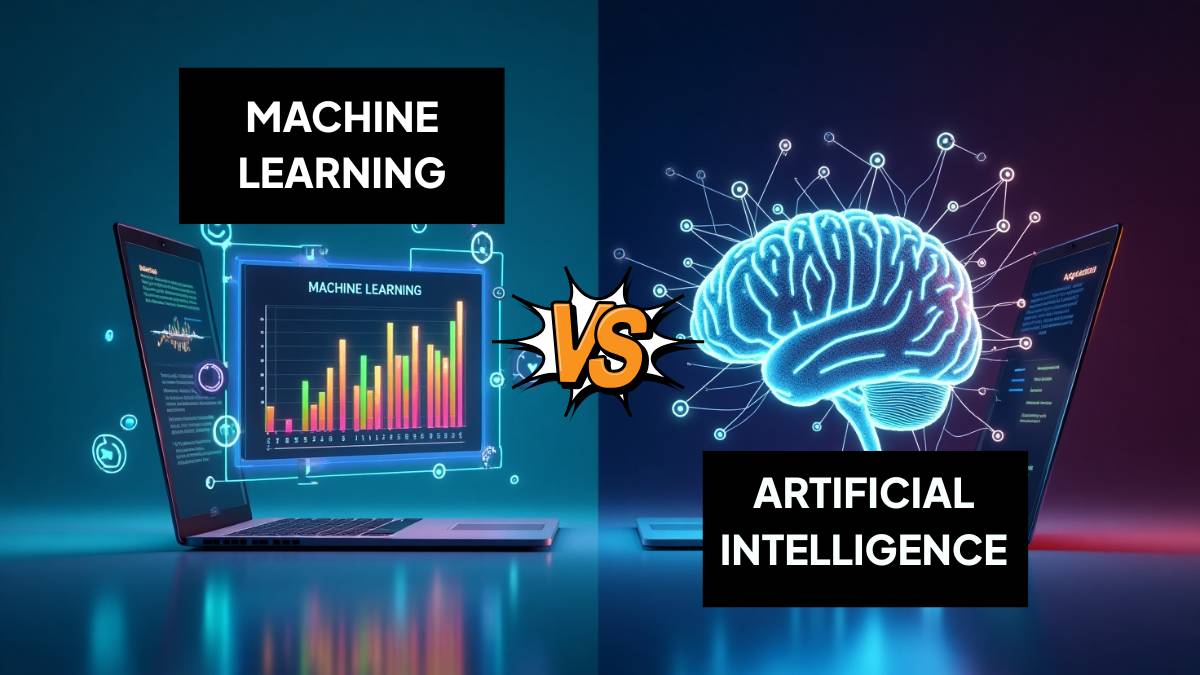Let’s be real, terms like Artificial Intelligence and Machine Learning get thrown around a lot these days. But most people still confuse the two. And honestly, it’s easy to see why. They’re connected, often used together, and the tech world loves to blur the lines with jargon.
Table of Contents
But here’s the thing, knowing the difference between machine learning and AI actually matters now. Whether you’re a marketer trying to automate campaigns, a business leader exploring new tools, or just someone curious about where tech is headed… it helps to get these basics right. Because from Alexa to ChatGPT, from Netflix suggestions to fraud alerts, this stuff is already shaping our daily lives. Let’s break it down in plain, simple language.
What is Artificial Intelligence (AI)?
Artificial Intelligence is a broad field in computer science that aims to build machines or systems that can simulate human intelligence. That means tasks like reasoning, problem-solving, understanding language, recognizing images, and making decisions.
Think of AI as the umbrella term. It covers everything from your voice assistant to futuristic robots that can have conversations or drive cars on their own.
Types of AI
AI isn’t just one thing, it’s divided into levels:

- Narrow AI (Weak AI): This is what we use today, systems designed for specific tasks. Think Siri, Google Translate, or facial recognition on your phone.
- General AI (Strong AI): Hypothetical for now, but this would mean machines that can think and learn like humans across any task.
- Super AI: This is the “sci-fi” level. Machines smarter than humans in every possible way. We’re not there (yet, hopefully?).
Also Read: Types of Artificial Intelligence Systems
Real-World Examples of AI
- Siri or Alexa: Understands your voice, responds to commands.
- ChatGPT: Converses like a human, writes content, solves problems.
- Autonomous vehicles: Use sensors + AI to make driving decisions.
Also Read: What is Planning in Artificial Intelligence
What is Machine Learning (ML)?
Machine Learning is a subset of AI. It’s one of the ways we actually build AI systems.
Rather than coding explicit instructions, we feed a machine data and let it learn patterns from that data to make decisions or predictions. The more data it gets, the smarter it becomes (in theory, at least).
Categories of Machine Learning
- Supervised Learning: Feed it labeled data (e.g., images of cats and dogs), and it learns to classify.
- Unsupervised Learning: No labels. It tries to find patterns on its own (like grouping customers by behavior).
- Reinforcement Learning: The system learns by trial and error, like teaching a robot to walk or an agent to play a video game.
Suppose you’re looking to deepen your understanding of machine learning principles such as supervised, unsupervised, and reinforcement learning, or to get hands-on experience with real-world datasets. In that case, there are a range of comprehensive courses available online. You can explore an interactive ML course at DataCamp that covers everything from introductory concepts to advanced topics like natural language processing, clustering, feature engineering, and more.
Real-World ML Examples
- Netflix recommendations
- Credit card fraud detection
- Email spam filters
- Image recognition in Google Photos
Also Read: Rational Agents in AI
AI vs Machine Learning: Core Differences
Here’s where things often get confusing. Let’s break down how AI and ML differ by looking at their:
Objective
- AI: To simulate human intelligence and decision-making.
- ML: To identify patterns and make data-driven predictions or decisions.
Approach
- AI: Can include logic, rules, decision trees, and more.
- ML: Relies on learning from data, not explicitly programmed rules.
Technology Stack
- AI: Includes ML, natural language processing (NLP), computer vision, expert systems, etc.
- ML: Uses algorithms (like decision trees, SVM, neural networks) to train models on data.
Data Dependency
- AI: Can be rule-based without massive datasets.
- ML: Needs large volumes of labeled or structured data to train effectively.
Output
- AI: Capable of reasoning and decision-making.
- ML: Predicts outcomes or classifies inputs based on past data.
Flexibility
- ML: A narrower focus, specific tasks.
- AI: Broader, more flexible framework (of which ML is a part).
Want to learn how to use AI and ML practically in your business or career?
Check out Young Urban Project’s hands-on workshops and AI Marketing Courses, designed for marketers, creators, and entrepreneurs.

Enroll Now: Learn Generative AI for Marketing
How AI and ML Work Together
Here’s a simple way to think about it:
AI is the brain. ML is the learning process.
ML acts as the engine that powers most modern AI applications. You can’t have advanced AI without ML working behind the scenes.
Deep Learning and Neural Networks
A quick word here, deep learning is a more advanced type of ML that uses neural networks (inspired by the human brain) to process data in complex layers. It’s how tools like ChatGPT, facial recognition, and language translators work at scale.
Real-World Synergy
- Chatbots: NLP (AI) + ML = bots that actually understand what you’re saying.
- Computer Vision: Self-driving cars use AI to “see” the road, powered by ML models trained on image data.
- Robotics: ML helps robots learn tasks; AI helps them make decisions about those tasks.
Key Similarities Between AI and ML
Let’s not forget, they’re part of the same tech family.
- Both are grounded in computer science, math, and data structures.
- They aim to automate and enhance efficiency.
- Both involve continuous learning, they get better over time.
- Used across a wide range of industries like healthcare, finance, eCommerce, education, and marketing.
Use Cases & Applications Across Industries
Let’s get practical. Here’s how AI and ML are changing the game:
Healthcare
- ML algorithms assist in diagnosing diseases.
- AI helps in drug discovery and analyzing complex medical data.
Finance
- Credit scoring based on spending behavior.
- Real-time fraud detection to flag suspicious transactions.
Retail & eCommerce
- Personalized product recommendations (Amazon, anyone?)
- Inventory prediction to reduce waste and overstock.
Marketing
- Predictive analytics for customer behavior.
- Ad targeting with dynamic creative optimization.
Also Read: What is AI Marketing?
Manufacturing
- Predictive maintenance of machinery.
- Automated quality control via image recognition.
Also Read: LLM vs Generative AI
How Organizations Can Leverage AI & ML
1. Spot the Right Business Problems
Look for areas that involve repetitive tasks, large datasets, or where better predictions could improve outcomes. Start small, like automating customer support or optimizing ad targeting, then scale once you see results.
2. Build Clean, Usable Data Systems
No matter how powerful the AI or ML tool is, it’s useless without good data. Invest in cleaning, organizing, and maintaining your data systems before jumping into fancy algorithms.
3. Use Ready-Made AI Tools First
You don’t need a data science team from day one. Platforms like Google AI, HubSpot, or ChatGPT can deliver real value quickly. Use them to test ideas and prove ROI before building anything custom.
4. Know When to Go Custom
Off-the-shelf tools work for many things, but if you’ve got a unique problem or process, a custom ML model might give you better performance and control. Just make sure the payoff is worth the build time.
5. Think Ethics and Risk Management
Bias, privacy, and transparency aren’t just buzzwords, they’re real concerns. Set clear policies, document decisions, and make sure your AI/ML projects are ethical, especially if they affect customers or employees directly.
Also Read: Essential Skills to Build AI Agents
Conclusion
So, let’s wrap it up. AI is the big-picture goal, making machines smart like humans. Machine learning is one of the most powerful ways we’re getting there, by helping systems learn from data without being explicitly programmed.
They’re different, but they work best together. AI sets the direction, ML drives the engine. And if you’re in business, marketing, tech, or honestly, any industry, it’s time to stop thinking of this stuff as futuristic. It’s already here, baked into your daily tools and shaping big decisions.
Understanding the difference between machine learning and AI isn’t just a technical thing, it’s a strategic one. Get clear on what they do, where they overlap, and how you can use both wisely.
FAQs
1. Is machine learning the same as artificial intelligence?
Not exactly. Machine learning is a part of artificial intelligence. AI is the broader concept of machines mimicking human thinking, while ML is a specific approach that allows machines to learn from data.
2. Can you use AI without machine learning?
Yes, you can. Early AI systems worked using predefined rules and logic without any learning. While ML powers most modern AI, some systems still rely on rule-based logic, especially for simpler tasks.
3. Which is more powerful: AI or ML?
AI is a bigger concept with more potential, including reasoning and planning. ML is one of the most effective tools within AI today. So ML is powerful in practice, but AI has broader capabilities.
4. How does deep learning relate to AI and ML?
Deep learning is a type of machine learning that uses neural networks to process complex data. It’s part of ML, which is itself part of AI. Think of it as the most advanced form of ML.
5. What skills are needed to work in AI and ML?
You’ll need a mix of programming (like Python), math (especially stats and linear algebra), and a solid grasp of algorithms. Knowledge of tools like TensorFlow or PyTorch also helps you build real models.
6. What’s the future of AI and ML in businesses?
Expect more automation, faster decision-making, and smarter personalization. AI and ML will continue transforming marketing, customer service, operations, and beyond, especially for businesses that learn how to use them strategically and ethically.

